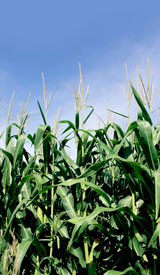January 12, 2009
Contact: Dr. Michael J. Baker, Cornell University, 607-255-5923; Cornell
Cooperative Extension: Clinton County: 518-561-7450; Essex:
518-962-4810; Franklin: 518-483-7403; Jefferson: 315-788-8450; Lewis:
315-376-5270; St. Lawrence: 315-379-9192
NNYADP Research First to Identify Beef Cattle Parasite as
Present in Region and Help Producers Develop Management Strategies
The presence of the large liver fluke has been confirmed in Northern New
York. Project leaders Cornell University Beef Extension Specialist Dr.
Michael J. Baker and veterinarian Dr. Laura B. Raymond positively
identified the large liver fluke (Fascioloides magna, also known as the
deer fluke) in beef livers at two of five slaughter plants in Northern
New York.
In addition to identifying the large liver fluke in the cattle livers at
the slaughter plants, Baker and Raymond are working with Northern New
York beef producers on management strategies to cope with this parasite.
Baker says, “This project was developed to answer the question is the
large liver fluke present in Northern New York. The answer is yes,
particularly in wet pasture areas. Now we need to learn more about how
the liver large fluke impacts cattle health. Currently, we can work with
producers to develop pasture management plans to reduce exposure.”
White-tailed deer shed the eggs of the large liver fluke into warm,
moist grasslands and pasture shared by livestock. The fluke’s eggs
migrate into freshwater snails that serve as an intermediate host. The
snails shed a tadpole-like form of the fluke into pastures where beef
cattle and other
grazing animals ingest the parasite and become the dead-end host for the
large liver fluke.
Dr. Raymond, a large animal veterinarian with the Watertown Animal
Hospital, says, “Clinical signs of cattle infected with large liver
flukes are difficult, if not impossible, to see. Diagnosis is currently
only possible with post-mortem examination of the liver at the slaughter
plants.”
The post-mortem presence of just one of the one-inch-wide,
one-to-three-inch-long, reddish-brown, leech-like large liver flukes in
a cattle liver is cause for condemnation of the liver, removing it from
the food supply per U.S. Department of Agriculture regulations. The rest
of the carcass can be processed as meat products.
Although the impact of the large liver fluke on beef cattle production
is not yet documented, producers suspect the parasite of damaging
reproductive efficiency, causing lower calf weights, and slowing heifer
growth.
Northern New York Agricultural Development Program Beef Subcommittee
member Ralph Chase says, “Because North Country beef producers are
increasing the use of grasslands to improve production and
profitability, the farmers of the Northern New York Agricultural
Development Program Beef Committee identified this research project as a
way to determine our level of risk and to develop practices for reducing
beef herd losses to the large liver fluke.”
Dr. Baker says, “The challenges with the large liver fluke are that
until now it has not been documented in this area of the U.S.; it can
only be diagnosed post-mortem; and no good control measures exist
compared to the small liver fluke (Fascioloides hepatica) which can be
controlled with currently available anthelmentics (parasite-killing or
expelling drugs).”
Raymond notes that a Michigan State University study is adding to the
study of the large liver fluke in an area with parallels to Northern New
York.
“Veterinarian Dr. Dan Grooms has written that while nearly 100 percent
of the livers of the first calves raised from heifers purchased under
the Michigan Beef Improvement Program study were condemned due to large
liver fluke, more than 90 percent of the calves graded mid-choice or
better for carcass quality. The calves were raised in the Upper
Peninsula area of Michigan which is agriculturally similar to Northern
New York,” Raymond says.
To help continue the monitoring of the presence of the large liver fluke
in Northern New York beef herds, Dr. Baker suggests that producers talk
with their meat processors about any damage seen in their cattle’s
livers and to work with the processors to collect a sample of any flukes
found for positive identification by the farm’s veterinarian.
Other species at risk of infection by the large liver fluke are dairy
cattle, sheep, goats, elk, moose and camelids.
For assistance in dealing with liver fluke infections, contact your
veterinarian or your local Cornell Cooperative Extension office. For
more information on beef production in Northern New York, go online to
the Northern New York Agricultural Development Program (NNYADP) website
at www.nnyagdev.org.
Collaborators on the NNYADP-funded large liver fluke research project
included Cornell Cooperative Extension educators Brent Buchanan (St.
Lawrence County), Anita Deming (Essex County), Ron Kuck (Jefferson
County), and Michele Ledoux (Lewis County). #
More Info
Scientific names: large liver fluke, or deer fluke:
Fascioloides magna; common liver fluke:
Fasciola hepatica.
Estimating Losses to Small Liver Flukes – Although the
small liver fluke can be controlled with drugs, a University of Florida
study (Liver Fluke Control in Beef Cattle by M.B. Irsik, Charles
Courtney III, and Ed Richey) reports that the Florida beef industry
loses $10 million annually to small liver fluke (Fascioloides hepatica)
infection. A 2000 National Beef Quality Audit by Colorado State
University, Oklahoma State University and Texas A&M University,
identified small liver fluke (Fascioloides hepatica) infestations among
top 10 beef quality issues with 24.1% of U.S. cows & bulls infected with
liver flukes at slaughter.



